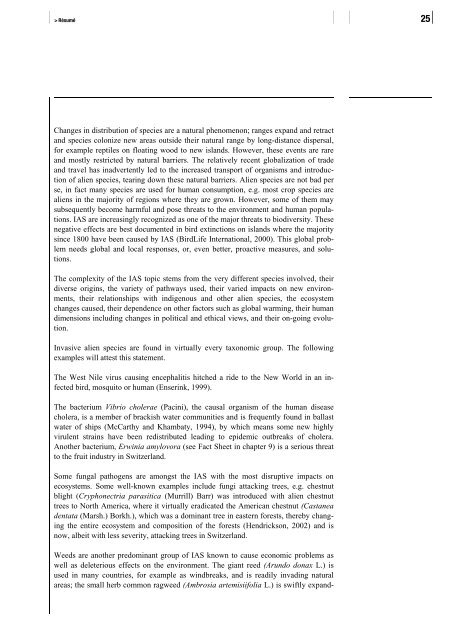Invasive alien species in Switzerland - Schweizer ...
Invasive alien species in Switzerland - Schweizer ...
Invasive alien species in Switzerland - Schweizer ...
You also want an ePaper? Increase the reach of your titles
YUMPU automatically turns print PDFs into web optimized ePapers that Google loves.
Résumé 25<br />
Changes <strong>in</strong> distribution of <strong>species</strong> are a natural phenomenon; ranges expand and retract<br />
and <strong>species</strong> colonize new areas outside their natural range by long-distance dispersal,<br />
for example reptiles on float<strong>in</strong>g wood to new islands. However, these events are rare<br />
and mostly restricted by natural barriers. The relatively recent globalization of trade<br />
and travel has <strong>in</strong>advertently led to the <strong>in</strong>creased transport of organisms and <strong>in</strong>troduction<br />
of <strong>alien</strong> <strong>species</strong>, tear<strong>in</strong>g down these natural barriers. Alien <strong>species</strong> are not bad per<br />
se, <strong>in</strong> fact many <strong>species</strong> are used for human consumption, e.g. most crop <strong>species</strong> are<br />
<strong>alien</strong>s <strong>in</strong> the majority of regions where they are grown. However, some of them may<br />
subsequently become harmful and pose threats to the environment and human populations.<br />
IAS are <strong>in</strong>creas<strong>in</strong>gly recognized as one of the major threats to biodiversity. These<br />
negative effects are best documented <strong>in</strong> bird ext<strong>in</strong>ctions on islands where the majority<br />
s<strong>in</strong>ce 1800 have been caused by IAS (BirdLife International, 2000). This global problem<br />
needs global and local responses, or, even better, proactive measures, and solutions.<br />
The complexity of the IAS topic stems from the very different <strong>species</strong> <strong>in</strong>volved, their<br />
diverse orig<strong>in</strong>s, the variety of pathways used, their varied impacts on new environments,<br />
their relationships with <strong>in</strong>digenous and other <strong>alien</strong> <strong>species</strong>, the ecosystem<br />
changes caused, their dependence on other factors such as global warm<strong>in</strong>g, their human<br />
dimensions <strong>in</strong>clud<strong>in</strong>g changes <strong>in</strong> political and ethical views, and their on-go<strong>in</strong>g evolution.<br />
<strong>Invasive</strong> <strong>alien</strong> <strong>species</strong> are found <strong>in</strong> virtually every taxonomic group. The follow<strong>in</strong>g<br />
examples will attest this statement.<br />
The West Nile virus caus<strong>in</strong>g encephalitis hitched a ride to the New World <strong>in</strong> an <strong>in</strong>fected<br />
bird, mosquito or human (Enser<strong>in</strong>k, 1999).<br />
The bacterium Vibrio cholerae (Pac<strong>in</strong>i), the causal organism of the human disease<br />
cholera, is a member of brackish water communities and is frequently found <strong>in</strong> ballast<br />
water of ships (McCarthy and Khambaty, 1994), by which means some new highly<br />
virulent stra<strong>in</strong>s have been redistributed lead<strong>in</strong>g to epidemic outbreaks of cholera.<br />
Another bacterium, Erw<strong>in</strong>ia amylovora (see Fact Sheet <strong>in</strong> chapter 9) is a serious threat<br />
to the fruit <strong>in</strong>dustry <strong>in</strong> <strong>Switzerland</strong>.<br />
Some fungal pathogens are amongst the IAS with the most disruptive impacts on<br />
ecosystems. Some well-known examples <strong>in</strong>clude fungi attack<strong>in</strong>g trees, e.g. chestnut<br />
blight (Cryphonectria parasitica (Murrill) Barr) was <strong>in</strong>troduced with <strong>alien</strong> chestnut<br />
trees to North America, where it virtually eradicated the American chestnut (Castanea<br />
dentata (Marsh.) Borkh.), which was a dom<strong>in</strong>ant tree <strong>in</strong> eastern forests, thereby chang<strong>in</strong>g<br />
the entire ecosystem and composition of the forests (Hendrickson, 2002) and is<br />
now, albeit with less severity, attack<strong>in</strong>g trees <strong>in</strong> <strong>Switzerland</strong>.<br />
Weeds are another predom<strong>in</strong>ant group of IAS known to cause economic problems as<br />
well as deleterious effects on the environment. The giant reed (Arundo donax L.) is<br />
used <strong>in</strong> many countries, for example as w<strong>in</strong>dbreaks, and is readily <strong>in</strong>vad<strong>in</strong>g natural<br />
areas; the small herb common ragweed (Ambrosia artemisiifolia L.) is swiftly expand-
















